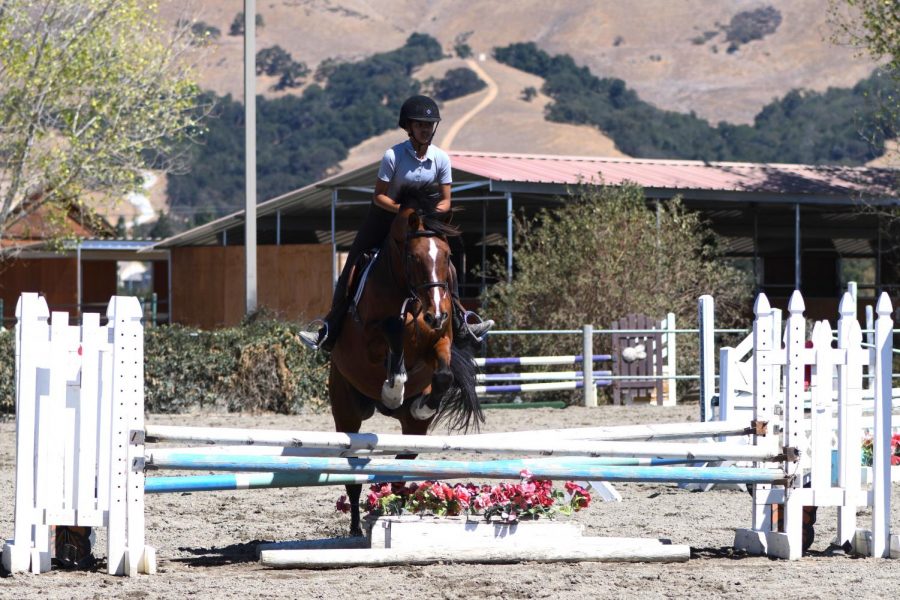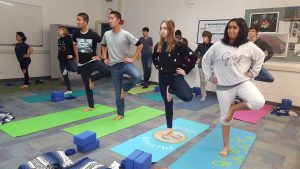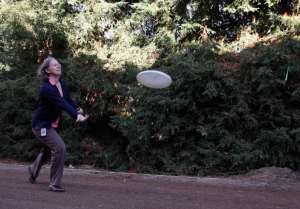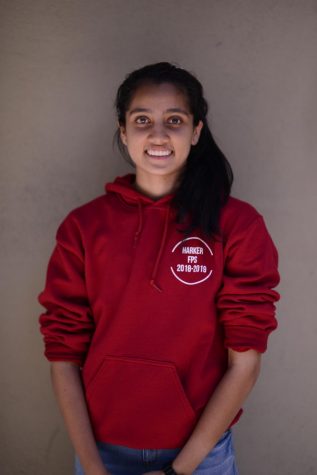Alternate Sports: The unconventional aspect of non-traditional sports doesn’t make them any less valuable
provided by Nilisha Baid
Nilisha Baid (10) and her horse Manny jump over a hurdle. After years of developing skills and enjoying horses, Nilisha joined the competitive program for horseback riding last year.
September 20, 2018
Sweat dripping in a constant stream down their exhausted faces and feet pounding across the lush, green field in an attempt to catch the flying disc, a group of teenage boys and girls laugh while playing Ultimate, also known as Ultimate frisbee, at the Heritage Oaks Park in Los Altos. The teens bask in the sunlight overhead, as they enjoy their last days of a fast-fading summer before school starts once again.
Informal, active, fun, friendly and encouraging in nature, non-traditional sports help people stay mentally and physically fit and also build self-confidence. With the increase in their popularity, sports climbing, karate, skateboarding and surfing will be introduced in 2020 Olympics in Tokyo. Ultimate will also potentially spin into the 2024 or 2028 Olympics.
Although not a traditional sport, Ultimate is popular, especially in the U.S., where it was founded in New Jersey around 50 years ago. According to physics teacher Dr. Miriam Allersma, a competitive and recreational Ultimate player for almost 15 years, people commonly misconceive that the sport is unathletic and mostly meant for hippies.
“We would just play to play… We wouldn’t even keep track of points…I almost love doing that more than competing,” Allersma said. “Then, you can just focus on having fun and you are not worried about what the score is and whether you are winning or losing or have to do better or worse.”
Another example of an alternate sport is horseback riding. Sophomore Nilisha Baid developed her passion for English horseback riding since first grade.
“It’s really interesting getting to work with an animal, because most sports are just with people,” she said.
Nilisha shares a special bond with her 19-year-old American Warmblood, Manny, who is dark brown with a black mane and tail. For shows, Manny goes by the name Manhattan. Holding both reins in her hand, wearing tall boots with spurs, a safety helmet and gloves, Nilisha feels exhilarated after a good ride with her loyal horse.
After years of developing skills and enjoying horses, Nilisha joined the competitive program for horseback riding last year. She commutes 45 minutes three times a week to train at the vast safe equestrian facility at Ligara Farms in Morgan Hill.
Nilisha works with Manny on hunters and equitation jumping, which focus more on technique rather than speed, as she is an experienced rider. She emphasized that alternate sports require dedication and discipline.
“It’s a lot harder than people think. A lot of times, people think you are sitting on the horse [and] they are doing all the work [while] you are just there, but it’s not like that. It is a lot of hard work,” Nilisha said. “In some aspects, it is more difficult [than traditional sports] since you have to be very focused on what your horse needs at certain times because someday your horse might be super excited [while] other days they are super lazy.”
Non-traditional sports provide an opportunity either for kids who stop playing traditional sports or to students to discover something new. Dr. Allersma, who also coached The University of Michigan team, shared her insight on Ultimate as a sport where students discovered or rediscovered their love for the game.
“We would get people who never played a sport before and wanted to try,” she said. “They had no idea they could be an athlete and a whole new world opened up to them. We would also get people who had played and quit mainstream sports in high school (often due to burn out). They found the joy in sport again.”
A 2017 poll by National Alliance for Youth Sports shows that around 70 percent of kids in the U.S. stop playing organized sports by the age of 13. Dr. Allersma surmises that one of the potential factors leading to this flight from traditional sports could be the pressure kids face to be successful and the expectation to play at an elite level in high school.
“For most traditional sports, there’s kid leagues and club teams and there’s recruitment for college and there’s all this structure, and I think that has a negative effect sometimes on the sport,” Allersma said. “But with Ultimate, there wasn’t this giant structure geared towards getting people into college and professional leagues and so the people that played because they wanted to…I think it had just had a more pure feeling, and I think it’s still possible in all those other sports.”


















![“[Building nerf blasters] became this outlet of creativity for me that hasn't been matched by anything else. The process [of] making a build complete to your desire is such a painstakingly difficult process, but I've had to learn from [the skills needed from] soldering to proper painting. There's so many different options for everything, if you think about it, it exists. The best part is [that] if it doesn't exist, you can build it yourself," Ishaan Parate said.](https://harkeraquila.com/wp-content/uploads/2022/08/DSC_8149-900x604.jpg)




![“When I came into high school, I was ready to be a follower. But DECA was a game changer for me. It helped me overcome my fear of public speaking, and it's played such a major role in who I've become today. To be able to successfully lead a chapter of 150 students, an officer team and be one of the upperclassmen I once really admired is something I'm [really] proud of,” Anvitha Tummala ('21) said.](https://harkeraquila.com/wp-content/uploads/2021/07/Screen-Shot-2021-07-25-at-9.50.05-AM-900x594.png)







![“I think getting up in the morning and having a sense of purpose [is exciting]. I think without a certain amount of drive, life is kind of obsolete and mundane, and I think having that every single day is what makes each day unique and kind of makes life exciting,” Neymika Jain (12) said.](https://harkeraquila.com/wp-content/uploads/2017/06/Screen-Shot-2017-06-03-at-4.54.16-PM.png)








![“My slogan is ‘slow feet, don’t eat, and I’m hungry.’ You need to run fast to get where you are–you aren't going to get those championships if you aren't fast,” Angel Cervantes (12) said. “I want to do well in school on my tests and in track and win championships for my team. I live by that, [and] I can do that anywhere: in the classroom or on the field.”](https://harkeraquila.com/wp-content/uploads/2018/06/DSC5146-900x601.jpg)
![“[Volleyball has] taught me how to fall correctly, and another thing it taught is that you don’t have to be the best at something to be good at it. If you just hit the ball in a smart way, then it still scores points and you’re good at it. You could be a background player and still make a much bigger impact on the team than you would think,” Anya Gert (’20) said.](https://harkeraquila.com/wp-content/uploads/2020/06/AnnaGert_JinTuan_HoHPhotoEdited-600x900.jpeg)

![“I'm not nearly there yet, but [my confidence has] definitely been getting better since I was pretty shy and timid coming into Harker my freshman year. I know that there's a lot of people that are really confident in what they do, and I really admire them. Everyone's so driven and that has really pushed me to kind of try to find my own place in high school and be more confident,” Alyssa Huang (’20) said.](https://harkeraquila.com/wp-content/uploads/2020/06/AlyssaHuang_EmilyChen_HoHPhoto-900x749.jpeg)










